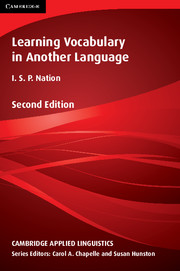Book contents
- Frontmatter
- Contents
- Series editors' preface
- Acknowledgements
- Introduction
- 1 The goals of vocabulary learning
- 2 Knowing a word
- 3 Teaching and explaining vocabulary
- 4 Vocabulary and listening and speaking
- 5 Vocabulary and reading and writing
- 6 Specialised uses of vocabulary
- 7 Vocabulary-learning strategies
- 8 Learning words from context
- 9 Word parts
- 10 Using dictionaries
- 11 Deliberate learning from word cards
- 12 Finding and learning multiword units
- 13 Testing vocabulary knowledge and use
- 14 Designing the vocabulary component of a language course
- Appendices
- Subject index
- Author index
4 - Vocabulary and listening and speaking
Published online by Cambridge University Press: 15 February 2018
- Frontmatter
- Contents
- Series editors' preface
- Acknowledgements
- Introduction
- 1 The goals of vocabulary learning
- 2 Knowing a word
- 3 Teaching and explaining vocabulary
- 4 Vocabulary and listening and speaking
- 5 Vocabulary and reading and writing
- 6 Specialised uses of vocabulary
- 7 Vocabulary-learning strategies
- 8 Learning words from context
- 9 Word parts
- 10 Using dictionaries
- 11 Deliberate learning from word cards
- 12 Finding and learning multiword units
- 13 Testing vocabulary knowledge and use
- 14 Designing the vocabulary component of a language course
- Appendices
- Subject index
- Author index
Summary
This chapter looks at opportunities for vocabulary learning through the oral skills of listening and speaking. With careful thought and planning, listening and speaking can be important means of vocabulary growth.
What vocabulary knowledge is needed for listening?
Learning vocabulary through listening is one type of learning through meaning-focused input. Learners would need at least 95% coverage of the running words in the input in order to gain reasonable comprehension and to have reasonable success at guessing from context. Van Zeeland and Schmitt (In press) found that 95% coverage was adequate for listening to informal narratives. Staehr (2009) found 98% coverage was needed for academic listening. A coverage of 98% (one unknown word in every 50 words, or about two or three unknown words per minute) is not surprisingly better than less coverage (Bonk, 2000; Hu and Nation, 2000; Schmitt et al., 2011; van Zeeland and Schmitt, 2012). Studies of spoken language, especially colloquial spoken language used in informal situations, indicate that a vocabulary of around 3,000 word families is needed to provide around 95% coverage (Adolphs and Schmitt, 2003, 2004; Webb and Rodgers, 2009a, 2009b). Around 5,000–6,000 words are needed to get 98% coverage. More formal academic spoken language makes more use of the vocabulary in the Academic Word List, which provides around 4% coverage of university lectures. Typically, as vocabulary size increases, so does written comprehension (Schmitt et al., 2011).
- Type
- Chapter
- Information
- Learning Vocabulary in Another Language , pp. 161 - 203Publisher: Cambridge University PressPrint publication year: 2013

